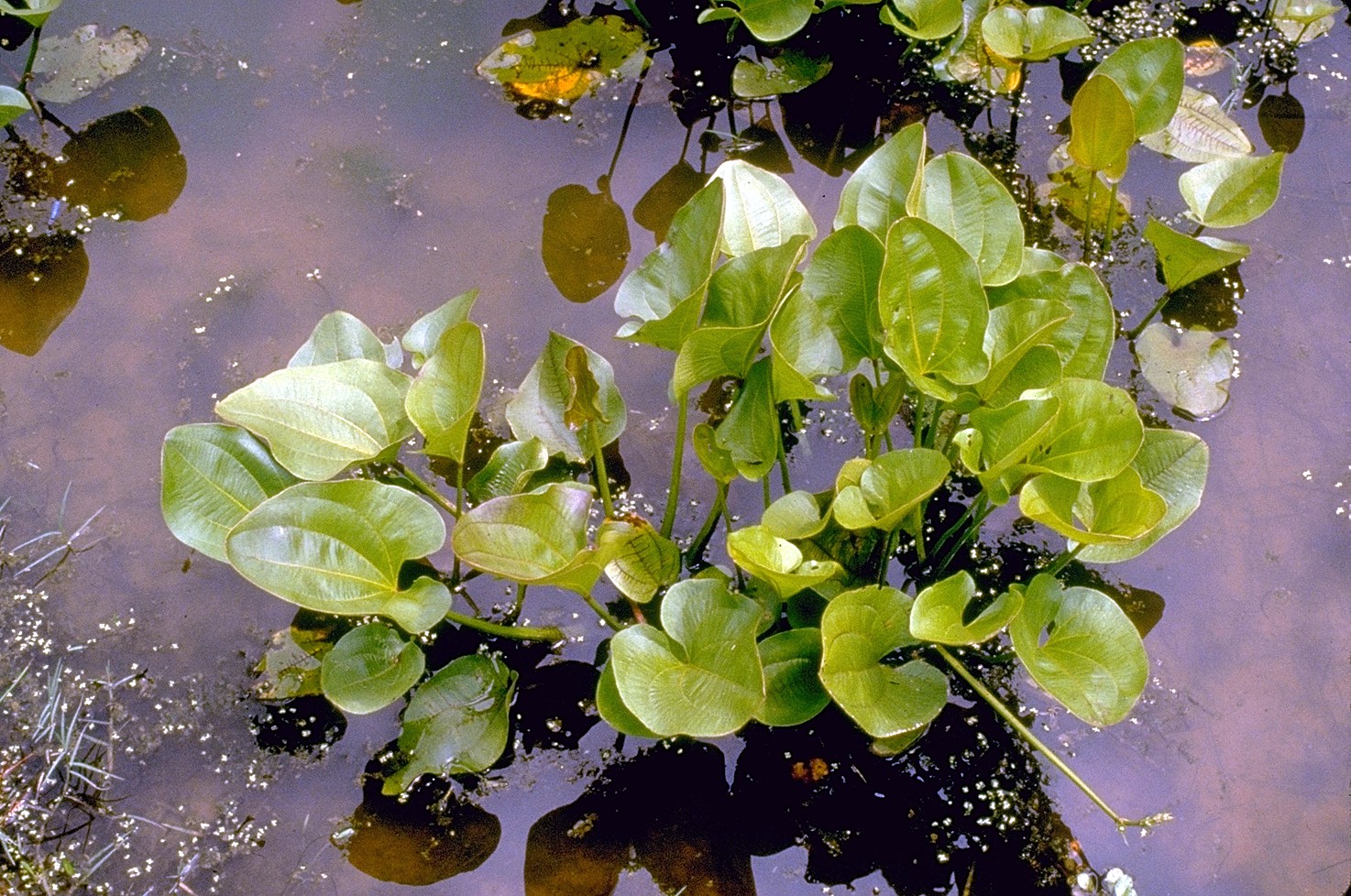- Echinodorus cordifolius
Taxobox
name = Echinodorus cordifolius

image_width = 240px
regnum =Plant ae
divisio =Magnoliophyta
classis =Liliopsida
ordo =Alismatales
familia =Alismataceae
genus = "Echinodorus "
species = "E. cordifolius"
binomial = "Echinodorus cordifolius"
binomial_authority = (L.) GrisebCommon names
Spade Leaf Sword, Creeping burhead"'
ynonyms
"E. radicans" (Nuttall) Engelmann; "Alisma cordifolia" Linnaeus, Sp. Pl. 1: 343. 1753
Distribution
Found in
wetland s inMexico andNorth America In USA it occurs in the southeastern states, to Virginia, Illinois and Texas. It is also found in Mexico and the northern states of South America.Ecological aspects
Found in marshes, swamps and ponds. Blooms in the late summer to early fall.
Description
Herbs , perennial, stout, to 100 cm;rhizomes present.Leaves emersed, submersed leaves mostly absent; petiole 5--6-ridged, 17.5--45 cm; blade with translucent markings distinct lines, ovate to elliptic, 6.5--32 ´ 2.5--19.1 cm, base truncate to cordate.Inflorescences racemes, of 3--9 whorls, each 3--15-flowered, decumbent to arching, to 62 ´ 8--18 cm, often proliferating; peduncles terete, 35--56 cm; rachis triangular; bracts distinct, subulate, 10--21 mm, coarse, margins coarse; pedicels erect to ascending, 2.1--7.5 cm.Flowers to 25 mm wide; sepals spreading, 10--12-veined, veins papillate;petals not clawed;stamens 22;anthers versatile;pistils 200--250.Fruits oblanceolate, plump, 3--4-ribbed, abaxially 1-keeled, 2--3.5 ´ 0.9--1.5 mm; glands 3--4; beak terminal,1--1.3 mm. 2n = 22.Echinodorus cordifolius is very easily determined, as it is the only species with arching to decumbent inflorescences. In addition, it is the only one with papillate veins on the sepals.
Cultivation
Easily cultivated in neutral to soft water and tropical to sub-tropical temperatures. Rich substrate and good light. Common in the cultivated
aquarium trade.Emersed plants readily produce
flowers andseeds but it can be grown submersed as well. Most plants sold are grown emersed on plant farms. Once submerged,leaves may die off before underwaterleaves develop. In theaquarium grow in the background as a specimen plant. Will soon outgrow a smalleraquarium but removing the floatingleaves will help keep it smaller and submerse. Needs a large, deepaquarium to grow properly. CO2 infusion helps stronger growth. A heavy feeder and for optimum growth a richsubstrate is needed, includingclay . If grown emerse it is prone to attacks byaphids . Not fussy as to water conditions, tropicalaquarium temperatures. Can be grown outdoors in warmer countries, won't tolerate frost. Likes a lot of light.Can be grown in or by the
pond in warmer climes. The seeds can be sown in shallow water.Forms
"Tropica Marble"," Marble Queen" has an attractive marbled leaf surface which tends to be lost in low light conditions. Tends to remain as a submerged plant longer than the type plant. Likes good substrate, CO2 and a strong light. Cultivated by Oriental Aquarium in Singapore.
"ovalis" is a small, orbiculate plant whose low, wide growth makes it suitable for small aquariums. Reaches a height of about 35cm with a width of about 30 cm.
"ssp. fluitans" is fast-growing, suitable for large aquariums. Less likely to grow up above the water surface. If it grows large enough, it forms large leaves just under the surface instead. Reaches a height of about 40cm.
References
"The Mud King : Echinodorus cordifolius", Tropical Fish Hobbyist, October 2007, vol LVI (2) #619
External links
* [http://plants.usda.gov/java/profile?symbol=ECCO3&photoID=ecco3_001_avd.tif Drawing]
* [http://www.echinodorus-online.de/English/Species/cordifolius_E/cordifolius_e.html Echinodorus site]
* [http://www.tropica.dk/productcard_1.asp?id=073E Tropica "Marble Queen"]
* [http://pick5.pick.uga.edu/mp/20q?search=Echinodorus+cordifolius Illustrations]
* [http://www.alabamaplants.com/Whitealt/Echinodorus_cordifolius_page.html Alabama plants - illustrated]
Wikimedia Foundation. 2010.
